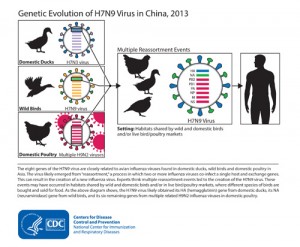H7N9 avian influenza: FAO calls on China’s neighbors to remain vigilant
PRESS RELEASE
20 January 2014, Rome – Human infections with the influenza A(H7N9) virus are on the rise again in China and the upcoming Chinese New Year festivities provide opportunity for further spread and human exposure, FAO warned today.
Millions of people and poultry are expected to be on the move and many households will slaughter poultry at home to celebrate the New Year. FAO called upon neighboring countries to remain vigilant in the face of A(H7N9) and other avian influenza viruses, such as highly pathogenic avian influenza H5N1.

This diagram depicts the origins of the H7N9 virus from China and shows how the virus’s genes came from other influenza viruses in birds. Image/CDC
The number of human infections with H7N9 has considerably increased since late December in East and Southeast China, according to the World Health Organization (WHO). The increase in cases was expected, as influenza viruses traditionally show increased activity during the winter months. So far, no other country has reported influenza A(H7N9) in humans, animals or in the market place.
There is strong evidence that people become infected following close contact with infected live poultry, mostly in live bird markets or when slaughtering birds at home. According to WHO, no sustained human-to-human transmission has occurred so far. Genetic analysis by FAO reference centers has revealed that the virus has not changed significantly since its emergence last year.
“Chinese authorities are enforcing important measures to reduce the risk of human exposure to the A(H7N9) virus,” said FAO Chief Veterinary Officer Juan Lubroth. “This includes temporary closures of live bird markets, regular market rest days, improved hygiene in markets, heightened and ongoing surveillance in poultry and live bird market environment, and control of poultry movements.”
Risk to humans remains
“But countries need to stay alert, as the virus continues to circulate in poultry without showing any visible clinical signs. The risk to humans remains, especially over the next few months and particularly during the Chinese New Year’s holiday period, ” Lubroth said.
FAO is assisting a number of member countries, particularly those that are at high risk, in preventing and preparing for possible A(H7N9) introductions into their poultry populations, conducting risk assessment, contingency planning and expansion of diagnostic capabilities, and risk based surveillance.
In South and South-East Asia, FAO, with strong support from the United States Agency for International Development (USAID), has assisted countries with the implementation of animal and environmental surveillance at live bird markets and on farms since June last year. FAO supported projects are also underway to assist some countries in Africa to prevent and be prepared for facing threats from avian influenza viruses, including A(H7N9).
Focusing on good biosecurity standards on farms and markets, regular market cleaning and disinfection, and targeted surveillance in areas that have direct or indirect live poultry trade with infected areas, are essential. If infection in animals is shown or suspected to be confined to a specific area, culling should be considered as long as it performed in a humane way with appropriate compensation paid to producers and marketers.
FAO continues to recommend producers and consumers the following standard precautions:
- Close contact with infected animals can put people at risk. Since influenza H7N9 causes little or no signs of disease in birds, it is crucial to separate living areas for animals from those of people.
- Seek immediate advice from your doctor if you show signs of fever after being in contact with poultry, farmed birds, wild birds or other animals.
- Wash your hands often to kill and remove microbes such as bacteria or viruses. You should always do so after handling birds or other animals, before and after preparing food, and before eating.
- Observe good hygiene practices such as keeping raw meat separate from cooked or ready-to-eat foods to avoid contamination, using separate utensils to prepare raw meats and other foods (e.g. chopping boards and other surfaces, knives, and plates, for instance) andwashing and disinfecting all surfaces and utensils that have been in contact with raw meat.
- Eat only well-cooked meat products (food reaches 70°C or more in all parts). Influenza viruses are not transmitted through consumption of well-cooked food. The consumption of raw meat and uncooked blood-based dishes is a high-risk practice.
- Keep different types of birds and other species of domestic animals apart. Screens, fencing or nets can be used to separate species from each other and help prevent possible transmission.
- Even though wild birds do not seem to be implicated in the spread of influenza A(H7N9), it is still considered good practice to limit access of wild birds to poultry and other domestic animals.
- Report sick or dead animals to the local veterinary (or public health) authorities. If this is not possible, tell your community leaders. Even though currently, influenza A(H7N9) does not cause illness in poultry, H5N1 does and it remains important that all signs of illness or sudden and unexplained deaths in poultry, farmed birds, wild birds or other animals are reported to the authorities so that they can deal with them safely and help stop any potentially damaging disease from spreading and limit/avoid subsequent human exposures.
- Do not eat sick or dead animals and do not give or sell them to others. Such animals, also, should not be fed to other animals.















[…] China reports new H7N9 deathecns7 more China bird flu cases in fresh wave of infectionFox NewsThe Global Dispatchall 58 news […]
[…] new H7N9 deathecnsShanghai Says Medical Worker Dies From H7N9 Bird FluBloombergFox News -The Global Dispatchall 59 news […]